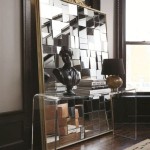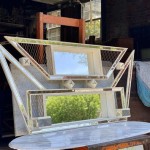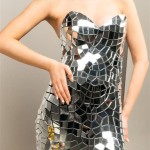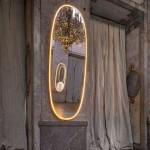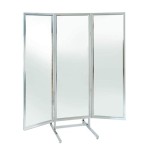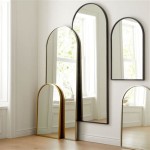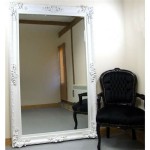How to Stick a Mirror to a Brick Wall
Attaching a mirror to a brick wall presents unique challenges due to the uneven and porous nature of brick. A successful installation requires careful preparation and the selection of appropriate adhesives. This guide outlines the necessary steps to securely and safely mount a mirror on a brick wall.
Surface Preparation: Crucial for Long-Term Adhesion
Before attempting to adhere the mirror, the brick surface must be thoroughly cleaned and prepared. Loose mortar, dust, and any other debris should be removed. A stiff brush is effective for initial cleaning. For stubborn dirt or efflorescence (salt deposits), a solution of muriatic acid diluted according to the manufacturer's instructions can be used. Always wear appropriate safety gear, including gloves and eye protection, when working with muriatic acid. Rinse the wall thoroughly with clean water after cleaning and allow it to dry completely.
Choosing the Right Adhesive: Matching Material to Task
The adhesive is critical for a secure and lasting bond. Several options are suitable for adhering a mirror to brick, each with its own advantages and disadvantages. Construction adhesive formulated for bonding mirrors is often recommended. These adhesives typically offer high strength and some flexibility to accommodate slight movements due to temperature changes. Another option is mirror mastic, a specialized adhesive designed specifically for mirrors. Mirror mastic offers excellent adhesion and is resistant to moisture. For heavier mirrors, a combination of mechanical fasteners and adhesive may be necessary for optimal support.
Applying the Adhesive: Ensuring Even Coverage and Support
The method of adhesive application depends on the specific product chosen. Always follow the manufacturer's instructions for proper application. Generally, construction adhesive is applied in a series of beads or dots to the back of the mirror. Avoid applying adhesive too close to the edges of the mirror to prevent it from squeezing out and creating a mess. Mirror mastic is usually applied in a similar manner. For larger mirrors, it is recommended to apply adhesive in a zig-zag pattern to ensure complete coverage and support.
Mounting the Mirror: Precision and Patience are Key
Once the adhesive is applied, carefully position the mirror on the brick wall. Use a level to ensure the mirror is straight both vertically and horizontally. Apply firm, even pressure to the mirror surface to ensure good contact with the adhesive. Depending on the adhesive used, temporary supports may be necessary to hold the mirror in place while it cures. These supports can be removed once the adhesive has reached its full strength, typically after 24 to 72 hours.
Considerations for Exterior Applications: Weatherproofing is Essential
If mounting a mirror outdoors, additional steps are required to protect it from the elements. Choose an adhesive specifically designed for exterior use and ensure the mirror is weatherproofed. Applying a sealant around the edges of the mirror can help prevent moisture from seeping behind it and causing damage. Consider the location carefully, avoiding areas exposed to direct sunlight or extreme temperature fluctuations, which can affect the adhesive and the mirror itself.
Dealing with Irregular Brick Surfaces: Adapting to the Challenge
Brick walls are rarely perfectly flat. Minor irregularities can be accommodated by using thicker adhesive beads or shims to level the mirror. For significantly uneven surfaces, consider applying a layer of backer board to the wall before mounting the mirror. This provides a smooth, even surface for adhesion and simplifies the installation process.
Safety Precautions: Protecting Yourself During Installation
Safety should always be a priority when undertaking any home improvement project. Wear appropriate safety gear, including gloves and eye protection, when handling adhesives and cleaning solutions. If using power tools, follow all safety guidelines provided by the manufacturer. Ensure adequate ventilation when working with adhesives or cleaning solutions that produce fumes. If working at heights, use a stable ladder or scaffolding and follow appropriate safety procedures.
Heavy Mirrors: Reinforcing the Support Structure
For particularly heavy or large mirrors, additional support may be required. Consider using mechanical fasteners, such as mirror clips or J-channels, in conjunction with adhesive. These fasteners provide extra security and prevent the mirror from shifting or falling. Consult a professional for advice on appropriate fastening methods for heavy mirrors.
Mirror Placement and Design Considerations: Aesthetics and Functionality
The placement of the mirror should be considered carefully. Think about the function of the mirror and its relationship to the surrounding space. For example, a mirror placed opposite a window can reflect natural light and brighten a room. Consider the overall aesthetic and choose a location that complements the existing décor.

How To Stick Mirror On Brick Wall Bunnings Work Community

How To Stick Mirror On Brick Wall Page 2 Bunnings Work Community

How To Stick Mirror On Brick Wall Bunnings Work Community

How To Stick Mirror On Brick Wall Bunnings Work Community

How To Stick Mirror On Brick Wall Bunnings Work Community

3 Simple Ways To Hang A Mirror On Wall Without Nails Wikihow

How To Stick Mirror On Brick Wall Page 2 Bunnings Work Community

3 Simple Ways To Hang A Mirror On Wall Without Nails Wikihow

How To Hang A Heavy Mirror Securely Bob Vila

3 Simple Ways To Hang A Mirror On Wall Without Nails Wikihow

